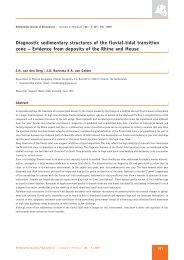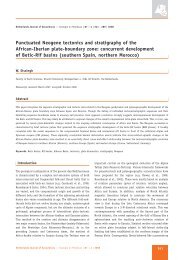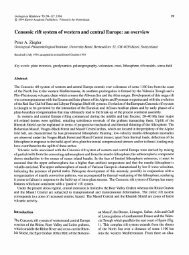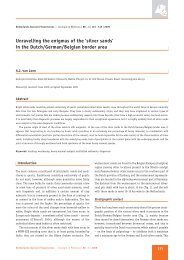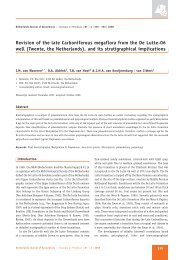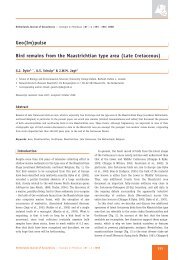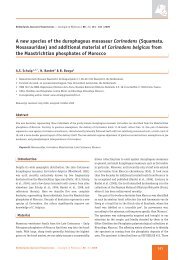full text - Netherlands Journal of Geosciences
full text - Netherlands Journal of Geosciences
full text - Netherlands Journal of Geosciences
Create successful ePaper yourself
Turn your PDF publications into a flip-book with our unique Google optimized e-Paper software.
Table 2. Skull proportion and dentition.<br />
Nothosaurus<br />
winterswijkensis 1 marchicus 2 TW480000375 TW480000376 TW480000378 winkelhorsti 3<br />
Snout – external naris<br />
Rostral constriction 1.08 1.04-1.15 1.14 1.17* 1.35* 1.1-1.4<br />
Snout – orbit<br />
Snout – external naris 1.98 1.86-1.88 1.87 - 1.83* 1.8-2<br />
Snout – upper temporal fossa<br />
Snout – external naris 3.25 3.15-3.19 3.36 - 3.05* 2.9-3.4<br />
Longitudinal ∅ external naris<br />
Transverse ∅ external naris 1.07 1.33-1.40 1.23 - 1.89 1-1.4<br />
Premaxillary dentition ?(5)/4 + 1 4+1 4+1 4+1 ? 5<br />
Maxillary dentition 5+2+(21-?) 3+2+(19-21) 3+2+(13-?) 4/5+2+(18+?) 3+2+(10+?) 5+2+23<br />
1 From the Winterswijk locality (Albers, 2005a).<br />
2 (Albers & Rieppel, 2003).<br />
3 In general (Rieppel & Wild, 1996).<br />
Nasal<br />
Frontal<br />
The nasals form most <strong>of</strong> the posterior margin <strong>of</strong> the external<br />
nares and are carrying slender anteromedial processes which<br />
line the entire medial margin <strong>of</strong> the external nares. As<br />
described above the nasals laterally contact the maxillae and<br />
posteriorly they contact the frontal, except for TW480000375<br />
where the left nasal also contacts the prefrontal excluding the<br />
maxilla from the frontal.<br />
Prefrontal<br />
The prefrontals are short and slender elements, lining the<br />
anteriomedial third <strong>of</strong> the dorsal orbit. Noticable is that, as the<br />
previously mentioned, only on the left side <strong>of</strong> TW480000375 a<br />
small anteromedial process <strong>of</strong> the prefrontal, as typical <strong>of</strong><br />
Nothosaurus winterswijkensis (Albers & Rieppel, 2003) excludes<br />
the maxilla from the frontal.<br />
Jugal<br />
The contacts between the frontals and maxilla and prefrontal<br />
have been extensively ascribed above. Their medial margins<br />
meet the antero-lateral margin <strong>of</strong> the nasals, and their lateral<br />
margins run parallel to the medial prefrontal. The body <strong>of</strong> the<br />
fused frontals forms an interorbital bridge and therefore<br />
separates the posterior prefrontal from the anterior part <strong>of</strong> the<br />
postfrontal. The medial processes <strong>of</strong> the frontals contact the<br />
parietal in a interdigitating suture.<br />
Postfrontal<br />
The postfrontal defines the posteromedial margin <strong>of</strong> the orbit.<br />
The posterior tip <strong>of</strong> the postfrontal is excluded from the<br />
anteromedial margin <strong>of</strong> the upper temporal fossa by a contact<br />
between postorbital and parietal.<br />
Postorbital<br />
In Nothosaurus winterswijkensis the jugal separates the posterior<br />
part <strong>of</strong> the maxilla from the postorbital and enters into the<br />
orbit completely excluding the maxilla from the postorbital<br />
(Albers & Rieppel, 2003). In Nothosaurus marchicus the maxilla<br />
and the postorbital meet close to the edge and thereby excluding<br />
the jugal from the orbit (Rieppel & Wild, 1996; Albers & Rieppel,<br />
2003). In TW480000378 however the jugal does not enter the<br />
orbit on the left side but does enter the orbit on the right side.<br />
In TW480000375 the jugal clearly enters the orbit on both sides<br />
and in TW480000378 the jugal seems to enter the orbit on the<br />
right side when the skull is examined in lateral view (but due<br />
to the solely ventral preparation the view is not optimal; on<br />
the left side the orbit is not visible).<br />
The postorbital has a broad medial process that forms almost the<br />
entire postorbital arch and thus defines the anterior margin <strong>of</strong><br />
the upper temporal fossa as well as the posterolateral margin <strong>of</strong><br />
the orbit. Anteriorly, the postorbital contacts the jugal, and<br />
posteriorly the postorbital enters the upper temporal arch.<br />
Parietal<br />
The parietal is unpaired (fused). The parietal diverges posteriorly<br />
to meet the squamosal at the posterior margin <strong>of</strong> the upper<br />
temporal fossa. Sutures in the occipital area are not very clear<br />
but the parietal does not seem to markedly deviate from<br />
Nothosaurus winterswijkensis or Nothosaurus marchicus, which<br />
do not differ in this respect. The position <strong>of</strong> the pineal foramen<br />
<strong>of</strong> TW480000375 is almost at the center <strong>of</strong> the parietal<br />
18<br />
<strong>Netherlands</strong> <strong>Journal</strong> <strong>of</strong> <strong>Geosciences</strong> — Geologie en Mijnbouw | 90 – 1 | 2011



